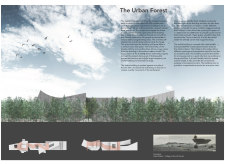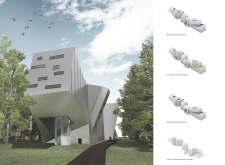5 key facts about this project
The facility located in Kemeri National Park, Latvia, combines various functions, including research, accommodations, and recreational spaces. Designed to accommodate around 40,000 visitors each year, the structure integrates with the natural environment. The design aims to allow the forest to expand into the site, creating a connection between the building and the landscape.
Design Concept
A linear structure inspired by the shape of an aircraft carrier defines the project. This design choice helps to establish a unique architectural presence while highlighting the theme of exploration within the forest. Positioning the building along one side of the site creates a visual boundary that aligns with the horizon, enhancing the interaction between the building and the surrounding landscape.
Spatial Arrangement
The linear layout supports easy movement throughout the facility, guiding visitors through various interconnected public spaces that lead toward the bogs. The relationship between the building, trees, and different levels provides visitors with multiple views and experiences. Openings in the design allow for natural light and fresh air, making the spaces feel open and inviting.
Courtyards and Connectivity
Courtyards are strategically placed within the design, adding complexity and promoting engagement with the landscape. These areas differ in orientation, allowing visitors to see the surroundings from different angles. A central linear bridge runs through the building, allowing for smooth circulation and reinforcing the experience of navigating through the space.
Materiality and Texture
The building's exterior is covered with metal panels, giving it a modern appearance while ensuring durability in the forest setting. This choice of material contributes to the overall aesthetic and is practical for withstanding the elements. The design accommodates various visitor needs, supporting both brief stops and longer stays.
The project invites exploration, with a series of openings that foster connections between indoor and outdoor spaces. As visitors move through the building, they maintain a relationship with the natural world, enhancing their overall experience in the park.





















































